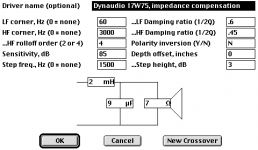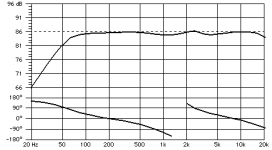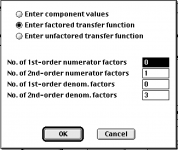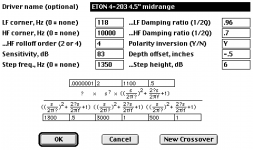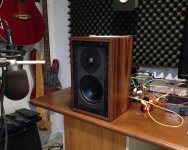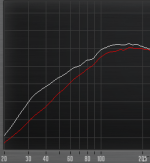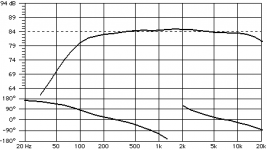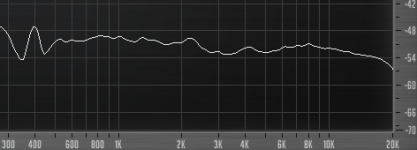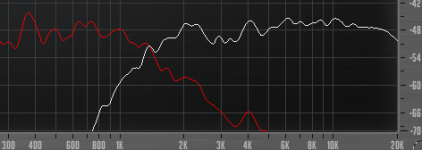I wrote these programs using Microsoft QuickBasic in the 1980's and 1990's, and am resurrecting them because there is so little modern Mac speaker design software available. The user interface (particularly that of LMP Pro) is embarrassingly poor even for the time period, but the programs are still useful.
You can run them on modern Macs by simply installing System761.zip, which bundles the BasiliskII emulator: Mac OS 9 for OS X/macOS
Once you've installed and started System761, drop the LMP.hqx and TB.hqx archive files onto the System761.app icon in your Applications folder. This automatically copies them to the desktop of the emulated computer. Now in the emulation open Mac68K HD > utilities > Stuffit Expander 5.5, and drop the archives onto Stuffit Expander.
LMP Professional is for crossover design. In some ways it is simplistic: you model your drivers by selecting the cutoff frequencies, slope, and Q that best approximate their response curves. Nonetheless there is basic support for modeling diffraction loss (response step) and interdriver time delay. You define the crossover either by providing component values for standard topologies or by entering the transfer function manually, and LMP plots the summed frequency and phase response. The program accompanied a 3-part 1987 article for Speaker Builder Magazine, An Introduction to Frequency Response and LMP, available here. Did I mention the user interface sucks?
TopBox was a collaboration with Joe D'Appolito, and has held up very well since it's inception in the 1990's. It supports 8 different closed, vented, and bandpass alignments and produces magnitude, max SPL, max input, and impedance plots. TopBox can automatically compute optimal box volume and tuning for a given driver.
You can run them on modern Macs by simply installing System761.zip, which bundles the BasiliskII emulator: Mac OS 9 for OS X/macOS
Once you've installed and started System761, drop the LMP.hqx and TB.hqx archive files onto the System761.app icon in your Applications folder. This automatically copies them to the desktop of the emulated computer. Now in the emulation open Mac68K HD > utilities > Stuffit Expander 5.5, and drop the archives onto Stuffit Expander.
LMP Professional is for crossover design. In some ways it is simplistic: you model your drivers by selecting the cutoff frequencies, slope, and Q that best approximate their response curves. Nonetheless there is basic support for modeling diffraction loss (response step) and interdriver time delay. You define the crossover either by providing component values for standard topologies or by entering the transfer function manually, and LMP plots the summed frequency and phase response. The program accompanied a 3-part 1987 article for Speaker Builder Magazine, An Introduction to Frequency Response and LMP, available here. Did I mention the user interface sucks?
TopBox was a collaboration with Joe D'Appolito, and has held up very well since it's inception in the 1990's. It supports 8 different closed, vented, and bandpass alignments and produces magnitude, max SPL, max input, and impedance plots. TopBox can automatically compute optimal box volume and tuning for a given driver.
Attachments
Last edited:
For technical types, LMP Pro lets you define the crossover in terms of the factored or unfactored transfer function, as well as via conventional component values. Here is an example for the midrange driver in a 3-way system.
Attachments
Another option is to install Wine for Mac (WineHQ - Run Windows applications on Linux, BSD, Solaris and macOS) which also requires Apple's X11 implementation. It will allow to run many windows applications, among them LSPCAD, an old 16bit shareware which i find quite useful.
This is nostalgia. I had TopBox running on my Powermac 7200, I recall it had problem with OS 8. I do did like the program 😉
FWIW I recently fired up LMP Pro on my 2015 MacBook via the BasiliskII emulator, and used it to design the crossover for this LS3/5A homage.
LMP Pro assumes a resistive load, so I used a zobel on the woofer. The tweeter did not need impedance compensation because I padded it down about 8 dB with series/parallel resistors which in this case reduce the effective impedance peak to only about 1 ohm.
I was gratified to see that LMP's summation frequency response for a 2nd order crossover agreed perfectly with measurements, including the effect of diffraction loss and the vertical lobing behavior (which you model in LMP by increasing/decreasing the "depth offset" of the drivers).
LMP Pro assumes a resistive load, so I used a zobel on the woofer. The tweeter did not need impedance compensation because I padded it down about 8 dB with series/parallel resistors which in this case reduce the effective impedance peak to only about 1 ohm.
I was gratified to see that LMP's summation frequency response for a 2nd order crossover agreed perfectly with measurements, including the effect of diffraction loss and the vertical lobing behavior (which you model in LMP by increasing/decreasing the "depth offset" of the drivers).
Attachments
...and attached is the TopBox prediction for sealed and vented versions of this speaker, compared with measurements. Good agreement except for the bottom octave, which is likely an artifact of my close mic technique.
Attachments
- Status
- Not open for further replies.
- Home
- Design & Build
- Software Tools
- Free crossover and box design software for Macs
